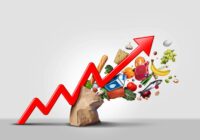This is part four of my series on why free market economics is a false religion. Be sure to check out parts one, two and three, and stay tuned for the rest.
December 2, 1942 — almost one full year after the attack on Pearl Harbor, the scientific community in the US was in a state of high anxiety. Physicists were sure that Hitler’s war machine, which had a two-year head start, was well on its way to developing a nuclear weapon. The race was on to create the first controlled nuclear chain reaction. If American scientists couldn’t make this happen, it would be impossible to construct a nuclear weapon of their own, and the war could be lost.
Working in secret in an unused squash court underneath the University of Chicago’s Stagg Field stands, scientists, students and laborers worked day and night piling 50- and 100-pound graphite bricks into a massive 771,000-pound egg-shaped reactor core. On the snowy afternoon of December 2, a few dozen people looked on nervously as cadmium rods were removed and the world’s first nuclear reactor was activated. Without any cooling or shielding system, it was possible that the world’s first fission reaction could also create the world’s first nuclear meltdown, right in the middle of the campus.
At 3:25 PM, the clicking of the Geiger counter confirmed that the experiment was a success, producing about enough energy to power a single light bulb. There were no cheers, toasts or hearty slaps on the back, although the researchers did pass around a bottle of chianti for a few celebratory sips. Graduate student Leona Woods described the mood in the room, saying, “There was a greater drama in the silence than if the words had been spoken.”
Later recognized as perhaps the greatest scientific experiment of the 20th century, team leader Enrico Fermi received the praise. An Italian physicist who used his trip to Sweden to accept the Nobel Prize as an opportunity to escape Mussolini and defect to the United States, Fermi was called “the Pope” by his peers. Recognized as alternatively the “architect of the nuclear age” or the “architect of the atomic bomb,” few scientists from the modern era are held in higher regard. And it all happened right on the University of Chicago campus, where Milton Friedman would join the faculty just five years later in 1946.
The transformation of economics from philosophy to science
In the 20th century, the world of academia was to witness more than one revolution in science. The revolution I want to talk about was a revolution of the boundaries of science itself.
There has been a longtime cleavage in the academic community between hard science and the humanities, or what were once known as physics and metaphysics. What’s the difference? Metaphysics is the study of abstract concepts like being and knowing — why are we here? In other words, it is philosophy, the quest for eternal truth.
Physicist Robert W. Wood was once asked to make a toast “to physics and metaphysics.” Wood then responded by describing the physicist’s journey from its first burst of inspiration. The next step, he said, is consulting existing literature bolstering that idea. The physicist then carefully prepares experiments to test that idea to see if it can withstand scrutiny in a lab. Finally, the physicist’s idea turns out to be wrong, so this idea is rejected, and our scientist moves on to something else. In the end, Wood diplomatically summarized the difference between physicists and metaphysicists: One has a laboratory and one does not.
Economics was not always considered a science. When Adam Smith was writing in the late 1700s, his area of study was known as “political philosophy.” Smith continued in the tradition of classical philosophers like Plato and Aristotle, who talked about some of the same basic ideas. At that time, economics had not completed its metamorphosis from political philosophy to political economics to just plain economics. Economics was squarely in the metaphysical realm.
However, embedded in Smith’s philosophical framework was the notion that society was a living organism. It was common then to see not just human beings as biological organisms but culture as a kind of organism. In the time after Smith, political philosophers increasingly saw societies as having balance and equilibrium like the rest of nature. This belief in equilibrium is one of the chief articles of faith of the free-market religion. Classical economists like Smith and neoclassical acolytes like Milton Friedman zeroed in on certain shared similarities of human beings to suggest that we are all motivated by the same essential laws of nature. In this way, economics began creeping from a social science, philosophy, to actual science.
This breakthrough led to what is now known as the Marginalist Revolution. As political economics gave way to just plain economics, everybody who was anybody began adopting an air of objectivity and impartiality as they used charts, graphs and complex equations to measure and size up precisely how economic transactions work.
Tending carefully as the first green shoots of this new branch were forming was Alfred Marshall, called by some the founder of modern economics. Marshall consciously tried to break this area of study free from its philosophical roots and cultivate a new, value-free science. He believed it was possible to apply the scientific method and calculus to measure marginal utility. In economics, utility is the benefit one gains from acquiring a product. Marginal utility is a way of conceptualizing that benefit into some kind of integer or measurable unit. (Science tends to pretend something doesn’t exist until some way is developed to measure it.) Once the proto-economists of Marshall’s era had a unit of measurement for economic theory, it became possible for them to start making predictions that seemed more scientific and less philosophical.
At the time, the marginalist method was once just one flavor among many taught. Aspiring economists studied marginalist texts mixed right in with Adam Smith and Karl Marx; “… it would be a long time before the uniformly mathematical approach we now associate with economics would establish dominance,” writes John Rapley. In the same way, early marginalists came from a broad spectrum of political orientations. Eventually, free market capitalism and marginalism joined together to establish a correct way for economics to be studied and understood.
Once the marginalists had developed a clean way of measuring economic theories, it was time for them to start mapping out the economic laws of nature. At last, their discipline could be as rigorous and mathematical as thermodynamics or chemistry. Demonstrating the laws of supply and demand would now be as self-evident as Newton’s law of universal gravitation. Mapping the law of scarcity would be as clear as when hydrocarbon reacts with oxygen to create combustion in a laboratory.
In the next part, we’ll take a closer look at how some of the old assumptions economists made when they were philosophers undercut their scientific claims. It’s one of my favorite parts of this whole series.
[Liam Roman edited this piece.]
[Let’s Make Them Pay first published this piece.]
The views expressed in this article are the author’s own and do not necessarily reflect Fair Observer’s editorial policy.
Support Fair Observer
We rely on your support for our independence, diversity and quality.
For more than 10 years, Fair Observer has been free, fair and independent. No billionaire owns us, no advertisers control us. We are a reader-supported nonprofit. Unlike many other publications, we keep our content free for readers regardless of where they live or whether they can afford to pay. We have no paywalls and no ads.
In the post-truth era of fake news, echo chambers and filter bubbles, we publish a plurality of perspectives from around the world. Anyone can publish with us, but everyone goes through a rigorous editorial process. So, you get fact-checked, well-reasoned content instead of noise.
We publish 2,500+ voices from 90+ countries. We also conduct education and training programs
on subjects ranging from digital media and journalism to writing and critical thinking. This
doesn’t come cheap. Servers, editors, trainers and web developers cost
money.
Please consider supporting us on a regular basis as a recurring donor or a
sustaining member.
Will you support FO’s journalism?
We rely on your support for our independence, diversity and quality.










Comment